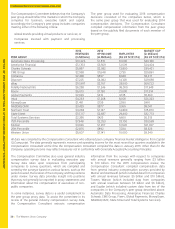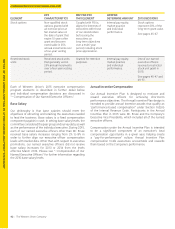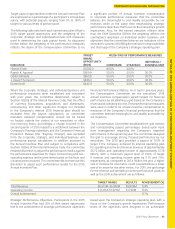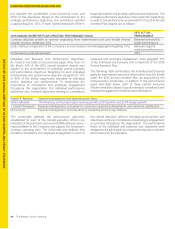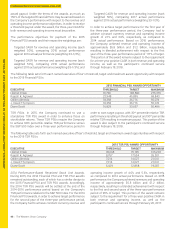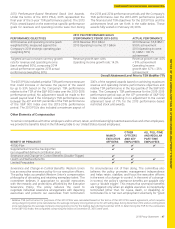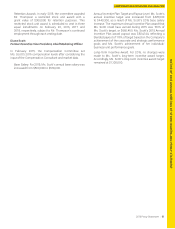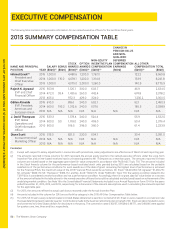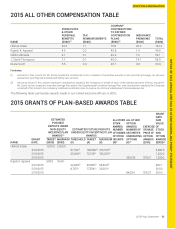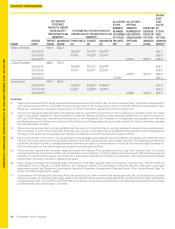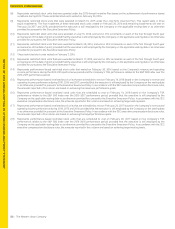Western Union 2015 Annual Report Download - page 66
Download and view the complete annual report
Please find page 66 of the 2015 Western Union annual report below. You can navigate through the pages in the report by either clicking on the pages listed below, or by using the keyword search tool below to find specific information within the annual report.
NOTICE OF 2016 ANNUAL MEETING OF STOCKHOLDERS AND PROXY STATEMENT
48 | The Western Union Company
COMPENSATION DISCUSSION AND ANALYSIS
reason” (including a material reduction in title or position,
reduction in base salary or bonus opportunity or an increase
in the executive’s commute to his or her current principal
working location of more than 50 miles without consent)
within 24 months after the date of a change-in-control.
Severance benefits under the policy are conditioned upon
the executive executing an agreement and release which
includes, among other things, non-competition and non-
solicitation restrictive covenants and a release of claims
against the Company. In addition, the Executive Severance
Policy prohibits excise tax gross-up payments on change-
in-control benefits for those individuals who became
executives of the Company after April 2009. Mr. Ersek is the
only Company employee who remains eligible for excise tax
gross-up payments. In connection with her March 2016
separation from the Company, Ms. Scott became eligible to
receive severance benefits under the terms of the Executive
Severance Policy.
Please see the “Executive Compensation—Potential
Payments Upon Termination or Change-in-Control” section
of this Proxy Statement for further information regarding the
Executive Severance Policy, including the amounts received
by Ms. Scott in connection with her departure, and the
treatment of awards upon qualifying termination events or a
change-in-control.
Retirement Savings Plans. Western Union executives on
United States payroll are eligible for retirement benefits
through a qualified defined contribution 401(k) plan,
the Incentive Savings Plan, and a non-qualified defined
contribution plan, the Supplemental Incentive Savings
Plan (“SISP”). The SISP provides a vehicle for additional
deferred compensation with matching contributions from
the Company. We maintain the Incentive Savings Plan
and the SISP to encourage our employees to save some
percentage of their cash compensation for their eventual
retirement. Mr. Ersek participates in the qualified defined
contribution retirement plan made available to eligible
employees in Austria. The committee believes that these
types of savings plans are consistent with competitive
pay practices, and are an important element in attracting
and retaining talent in a competitive market. Please see
the 2015 Nonqualified Deferred Compensation Table in the
“Executive Compensation” section of this Proxy Statement
for further information regarding Western Union’s retirement
savings plans.
Benefits and Perquisites. The Company’s global benefit
philosophy for employees, including executives, is to provide
a package of benefits consistent with local practices and
competitive within individual markets. Each of our named
executive officers participates in the health and welfare
benefit plans and fringe benefit programs generally available
to all other Western Union employees in the individual
market in which they are located. In addition, in 2015 the
Company provided the benefits and perquisites as described
in the 2015 Summary Compensation Table in the “Executive
Compensation” section of this Proxy Statement.
The Company provided its named executive officers with
competitive perquisites and other personal benefits that are
consistent with the Company’s philosophy of attracting and
retaining exemplary executive talent and, in some cases,
such as the annual physical examination, the Company
provides such personal benefits because the Compensation
Committee believes they are in the interests of the Company
and its stockholders. The committee periodically reviews the
levels of perquisites and other personal benefits provided to
named executive officers.
Employment Agreements. The Company generally executes
an offer of employment before an executive joins the
Company. This offer describes the basic terms of the
executive’s employment, including his or her start date,
starting salary, bonus target and long-term incentive award
target. The terms of the executive’s employment are based
thereafter on sustained good performance rather than
contractual terms, and the Company’s policies, such as the
Executive Severance Policy, will apply as warranted.
Under certain circumstances, the Compensation Committee
recognizes that special arrangements with respect to an
executive’s employment may be necessary or desirable.
For example, Mr. Ersek, the Company, and a subsidiary of
the Company entered into agreements in November 2009
relating to his 2009 promotion to Chief Operating Officer,
which were amended effective September 2010 to reflect
his 2010 promotion to President and Chief Executive Officer.
Employment contracts are a competitive market practice in
Austria where Mr. Ersek resided at the time he assumed his
position as Chief Operating Officer and the Compensation
Committee believes the terms of his agreements are
consistent with those for similarly situated executives in
Austria. Please see the “Executive Compensation—Narrative
to Summary Compensation Table and Grants of Plan-Based
Awards Table—Employment Arrangements” section of this
Proxy Statement for a description of the material terms of
Mr. Ersek’s employment agreement.
Stock Ownership Guidelines
To align our executives’ interests with those of our
stockholders and to assure that our executives own
meaningful levels of Western Union stock throughout their
tenures with the Company, the Compensation Committee
established stock ownership guidelines that require each
of the named executive officers to own Company Common
Stock worth a multiple of base salary. Under the stock
ownership guidelines, the executives must retain, until the
required ownership guideline levels have been achieved and
thereafter if required to maintain the required ownership
levels, at least 50% of after-tax shares resulting from the
vesting of restricted stock and restricted stock units and
at least 50% of the shares acquired upon exercise of stock
options after the payment of the exercise price, broker fees,
and related tax withholding obligations. The chart below
shows the salary multiple guidelines and the equity holdings
that count towards the requirement as of March 14, 2016. Each
continuing named executive officer has met, or is progressing
towards meeting, his respective ownership guideline.


